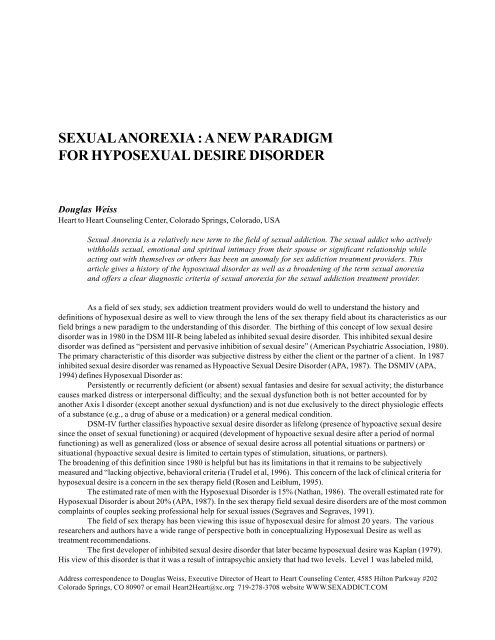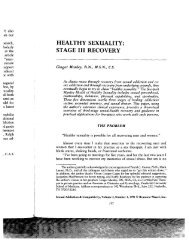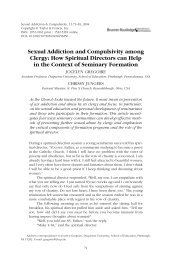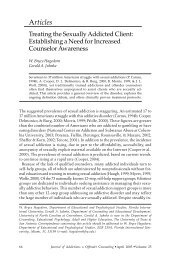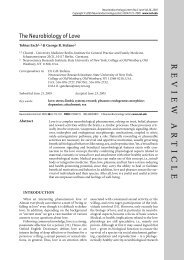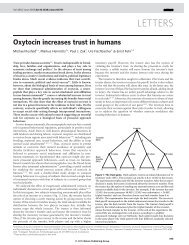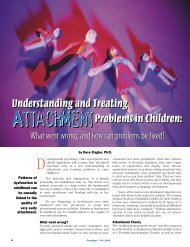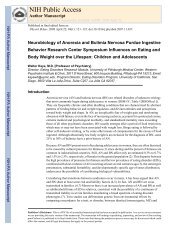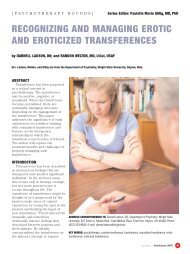sexual anorexia : a new paradigm for hyposexual desire disorder
sexual anorexia : a new paradigm for hyposexual desire disorder
sexual anorexia : a new paradigm for hyposexual desire disorder
You also want an ePaper? Increase the reach of your titles
YUMPU automatically turns print PDFs into web optimized ePapers that Google loves.
SEXUAL ANOREXIA : A NEW PARADIGMFOR HYPOSEXUAL DESIRE DISORDERDouglas WeissHeart to Heart Counseling Center, Colorado Springs, Colorado, USASexual Anorexia is a relatively <strong>new</strong> term to the field of <strong>sexual</strong> addiction. The <strong>sexual</strong> addict who activelywithholds <strong>sexual</strong>, emotional and spiritual intimacy from their spouse or significant relationship whileacting out with themselves or others has been an anomaly <strong>for</strong> sex addiction treatment providers. Thisarticle gives a history of the hypo<strong>sexual</strong> <strong>disorder</strong> as well as a broadening of the term <strong>sexual</strong> <strong>anorexia</strong>and offers a clear diagnostic criteria of <strong>sexual</strong> <strong>anorexia</strong> <strong>for</strong> the <strong>sexual</strong> addiction treatment provider.As a field of sex study, sex addiction treatment providers would do well to understand the history anddefinitions of hypo<strong>sexual</strong> <strong>desire</strong> as well to view through the lens of the sex therapy field about its characteristics as ourfield brings a <strong>new</strong> <strong>paradigm</strong> to the understanding of this <strong>disorder</strong>. The birthing of this concept of low <strong>sexual</strong> <strong>desire</strong><strong>disorder</strong> was in 1980 in the DSM III-R being labeled as inhibited <strong>sexual</strong> <strong>desire</strong> <strong>disorder</strong>. This inhibited <strong>sexual</strong> <strong>desire</strong><strong>disorder</strong> was defined as “persistent and pervasive inhibition of <strong>sexual</strong> <strong>desire</strong>” (American Psychiatric Association, 1980).The primary characteristic of this <strong>disorder</strong> was subjective distress by either the client or the partner of a client. In 1987inhibited <strong>sexual</strong> <strong>desire</strong> <strong>disorder</strong> was renamed as Hypoactive Sexual Desire Disorder (APA, 1987). The DSMIV (APA,1994) defines Hypo<strong>sexual</strong> Disorder as:Persistently or recurrently deficient (or absent) <strong>sexual</strong> fantasies and <strong>desire</strong> <strong>for</strong> <strong>sexual</strong> activity; the disturbancecauses marked distress or interpersonal difficulty; and the <strong>sexual</strong> dysfunction both is not better accounted <strong>for</strong> byanother Axis I <strong>disorder</strong> (except another <strong>sexual</strong> dysfunction) and is not due exclusively to the direct physiologic effectsof a substance (e.g., a drug of abuse or a medication) or a general medical condition.DSM-IV further classifies hypoactive <strong>sexual</strong> <strong>desire</strong> <strong>disorder</strong> as lifelong (presence of hypoactive <strong>sexual</strong> <strong>desire</strong>since the onset of <strong>sexual</strong> functioning) or acquired (development of hypoactive <strong>sexual</strong> <strong>desire</strong> after a period of normalfunctioning) as well as generalized (loss or absence of <strong>sexual</strong> <strong>desire</strong> across all potential situations or partners) orsituational (hypoactive <strong>sexual</strong> <strong>desire</strong> is limited to certain types of stimulation, situations, or partners).The broadening of this definition since 1980 is helpful but has its limitations in that it remains to be subjectivelymeasured and “lacking objective, behavioral criteria (Trudel et al, 1996). This concern of the lack of clinical criteria <strong>for</strong>hypo<strong>sexual</strong> <strong>desire</strong> is a concern in the sex therapy field (Rosen and Leiblum, 1995).The estimated rate of men with the Hypo<strong>sexual</strong> Disorder is 15% (Nathan, 1986). The overall estimated rate <strong>for</strong>Hypo<strong>sexual</strong> Disorder is about 20% (APA, 1987). In the sex therapy field <strong>sexual</strong> <strong>desire</strong> <strong>disorder</strong>s are of the most commoncomplaints of couples seeking professional help <strong>for</strong> <strong>sexual</strong> issues (Segraves and Segraves, 1991).The field of sex therapy has been viewing this issue of hypo<strong>sexual</strong> <strong>desire</strong> <strong>for</strong> almost 20 years. The variousresearchers and authors have a wide range of perspective both in conceptualizing Hypo<strong>sexual</strong> Desire as well astreatment recommendations.The first developer of inhibited <strong>sexual</strong> <strong>desire</strong> <strong>disorder</strong> that later became hypo<strong>sexual</strong> <strong>desire</strong> was Kaplan (1979).His view of this <strong>disorder</strong> is that it was a result of intrapsychic anxiety that had two levels. Level 1 was labeled mild,Address correspondence to Douglas Weiss, Executive Director of Heart to Heart Counseling Center, 4585 Hilton Parkway #202Colorado Springs, CO 80907 or email Heart2Heart@xc.org 719-278-3708 website WWW.SEXADDICT.COM
Douglas Weiss, Ph.D.which included guilt over <strong>sexual</strong> pleasure. Level 2 was moderate which involved fear of intimacy or a deep anxiety offear of injury. This pioneer of hypo<strong>sexual</strong> <strong>desire</strong> developed a three-phase model of <strong>sexual</strong> response cycle including<strong>desire</strong>, excitement and orgasm. Separate neurophysiologic pathways (Kaplan 1979) mediated these phases according toKaplan.Sexual trauma of an individual has been seen as a contributing factor of those who have hypo<strong>sexual</strong> <strong>disorder</strong>(Rosen and Leiblum, 1995). In one study that was retrospective of 372 <strong>sexual</strong> assault survivors close to 85% of thesesurvivors had <strong>sexual</strong> arousal or <strong>desire</strong> issues (Becker et al, 1986).In a male study of those who have hypo<strong>sexual</strong> <strong>disorder</strong> the sample reported a significantly higher frequency ofmasturbation compared to the control group (Nutter and Condron, 1985). This may be a helpful fact <strong>for</strong> those in thetreatment of <strong>sexual</strong> addiction, which often includes a significant masturbation pattern.The field of sex therapy also looks at hypo<strong>sexual</strong> <strong>disorder</strong> from a relationship perspective. Fears of intimacy,fear of closeness, fears of commitment and fears of abandonment where brought <strong>for</strong>th by LoPiccolo and Friedman (1988)as contributors to the hypo<strong>sexual</strong> <strong>disorder</strong>. They go on to state that: control issues directed toward self or partner; aninability to fuse feelings of love and <strong>sexual</strong> <strong>desire</strong>; and unresolved feelings of anger, hatred, and resentment may all playcausal roles in creating and maintaining hypoactive <strong>sexual</strong> <strong>desire</strong> (LoPiccio and Friedman, 1988)Trudel (1995) discusses several characteristics that he believes contributes to hypo<strong>sexual</strong> <strong>disorder</strong> including:“Cognitive distortions related to hypoactive <strong>sexual</strong> <strong>desire</strong> could be investigated by identifying rigid, irrational beliefsand unreasonable expectations about <strong>sexual</strong>ity, negative self-talk as a result of early trauma or the effects of a morallystrict religious upbringing also require identification.”Beck (1995) also sites relational factors that can play a major role in Hypo<strong>sexual</strong> Disorder including lack of trustand intimacy, conflicts over power and control and lack of physical attraction. Beck (1995) also mentions other issuesthat may contribute to low <strong>sexual</strong> <strong>desire</strong> in a client that include: depression, grief, chronic pain, sleep deprivation, bodyimage problems, low self esteem, alcohol or substance abuse, chronic mental or physical illness and the taking of certainprescription drugs.Treatment PerspectivesIn the assessment phase of hypo<strong>sexual</strong> <strong>disorder</strong> the clinician is to also assess <strong>for</strong> other <strong>sexual</strong> dysfunction’ssuch as erectile <strong>disorder</strong>s, premature ejaculation as well as inorgasmic functioning according to Trudel, Boulos, andMatte (1993), Heiman, Epps and Ellis (1995) suggest 3 categories of importance in assessing clients with Hypo<strong>sexual</strong>Disorder:Individual patters: Current and historical, physical health including illness, surgeries and medications;psychological functioning; solo <strong>sexual</strong> activity such as masturbation and fantasy; genderidentity; <strong>sexual</strong> orientation.Interpersonal patterns: Current and historical relationships; family patterns; <strong>sexual</strong> relationships.Sociocultural patterns: Current and historical beliefs about sex; gender, <strong>sexual</strong> orientation; importance ofreligion.Beck (1995) as well as Heiman, Epps and Ellis (1995) provide a condensed review of the studies compiled in thefield of sex therapy on hypo<strong>sexual</strong> <strong>disorder</strong>. The findings generally support that a modified Masters and Johnsonapproach including cognitive behavioral approaches, education, skills, learning, desensitization as well as directiveintervention and at home exercises can be measurably helpful in treating hypo<strong>sexual</strong> <strong>disorder</strong>. The combinations thatappeared to be most useful in this review of literature were those who combined the Master and Johnson approach withcouple therapy and or additional orgasm consistency training. Trudel (1996) also states that communication skilldevelopment is important in the treatment of hypo<strong>sexual</strong> <strong>desire</strong>.
SEXUAL ANOREXIA : A NEW PARADIGMSexual Anorexia: A New ParadigmThis framework of understanding hypo<strong>sexual</strong> <strong>desire</strong> from the field of sex therapy can lead us now into a broader<strong>paradigm</strong> of understanding this dynamic and <strong>disorder</strong> of hypo<strong>sexual</strong> <strong>desire</strong> in the field of <strong>sexual</strong> addiction. Heiman,Epps and Ellis state: “The therapist can also offer to the clients <strong>new</strong> ways of understanding and conceptualizing theproblem on any one of the levels. To do this with some success, however, the therapist must find an explanation thatfits several levels of the couple’s reality.”As a clinical and scientific community, we have done well at identifying the issue of <strong>sexual</strong> addiction. As aprofessional body it has taken us longer to develop clinical criteria <strong>for</strong> <strong>sexual</strong> addiction. The same is true of the issue of<strong>sexual</strong> <strong>anorexia</strong>. The beginning of the term <strong>sexual</strong> <strong>anorexia</strong> was used in our field in a roundtable discussion at theNational Council of Sexual Addiction Researchers in 1992 in Dallas, Texas. The group began to create a language <strong>for</strong>what as a clinical community we were experiencing in our treatment of <strong>sexual</strong> addiction.The fact that there were people outside a committed relationship but that this same person was minimallyinvolved or not involved at all <strong>sexual</strong>ly with their committed partner. This pattern of <strong>sexual</strong> inactivity continued with theprimary partner even if the <strong>sexual</strong> addict was by all appearances in active recovery from <strong>sexual</strong> addiction. As the yearswent by and we as a clinical community were experiencing this nationwide, we began to identify a <strong>paradigm</strong> expansion inour field of <strong>sexual</strong> addiction, which became identified as <strong>sexual</strong> <strong>anorexia</strong>.Sexual <strong>anorexia</strong> defined by Carnes (1997) as “Those who could not <strong>for</strong>ce themselves to be <strong>sexual</strong> without direinternal consequences” and “an obsessive state in which the physical, mental and emotional task of avoiding sexdominates ones life”. Weiss (1998)defines <strong>sexual</strong> <strong>anorexia</strong> as “The active, almost compulsive withholding of emotional,spiritual and <strong>sexual</strong> intimacy from the primary partner.” It is the consistent sabotaging of any ongoing intimacy in amarriage or committed relationship.Carnes and Weiss address the causes of <strong>sexual</strong> <strong>anorexia</strong>. In Carnes’(1997) book Sexual Anorexia: Overcoming<strong>sexual</strong> self-hatred, he addressed what he calls the personal histories of a <strong>sexual</strong> anorexic: 1) A probable history of <strong>sexual</strong>exploitation or severely traumatic <strong>sexual</strong> rejection, 2) Families of anorexics may present extreme patterns of behavior orthought. 3) A deep influence by a cultural, social or religious group that views sex negatively and supports <strong>sexual</strong>oppression and repression. Weiss (1998)in the video Sexual Anorexia: Beyond Sexual, Emotional & Spiritual Withholdingalso identifies three probable causes <strong>for</strong> <strong>sexual</strong> <strong>anorexia</strong> to develop: 1) Sexual abuse, 2) Attachment Disorder with thecross-gender parent and, 3) <strong>sexual</strong> addiction. The anorexic may present one, two or all three causes <strong>for</strong> the <strong>sexual</strong>anorexic behaviors. The issue of <strong>sexual</strong> abuse covered by Carnes and Weiss is easily understood to relate to <strong>sexual</strong><strong>anorexia</strong>. The emotional, spiritual and physiological trauma connected to ones <strong>sexual</strong>ity can lead to a variety of <strong>sexual</strong>and interpersonal responses, <strong>sexual</strong> <strong>anorexia</strong> being just one a person may choose.The issue of family of origin can also be understood to contribute to <strong>sexual</strong> <strong>anorexia</strong>, as child needs intimacyand nurturing from its primary caregivers. The lack of intimacy or the consistent absence of or the violation of thisintimacy can lead a child to associate discom<strong>for</strong>t pain or at best unfamiliarity with intimacy. Weiss contends that thecross gender parents model of intimacy can be a duplication of how the person expects or <strong>desire</strong>s a cross genderintimate relationship to be in their committed relationships.The issue of <strong>sexual</strong> addiction being a causal affect <strong>for</strong> <strong>sexual</strong> <strong>anorexia</strong> must be addressed by the cliniciantreating <strong>sexual</strong> addiction. Weiss(1998) contends that the early <strong>sexual</strong> rein<strong>for</strong>cement being bonded to the fantasy world(with or without pornography) and being maintained through adulthood can lead a person to primarily <strong>sexual</strong>ly bond tothe other world. The neurological chemical bonds to the unreal world combined with the psychological ease of afantasy world can allow a person to conclude the altered state fantasy world is not only easier psychological and<strong>sexual</strong>ly but preferred. Once the individual makes this conclusion whether in there 20’s or 50’s the <strong>anorexia</strong> symptomswill follow.Carnes(1997) sees the symptom cluster of the <strong>sexual</strong> anorexic as primarily <strong>sexual</strong>:“A dread of <strong>sexual</strong> pleasureA morbid and persistent fear of <strong>sexual</strong> contactObsession and hypervigilance around <strong>sexual</strong> mattersAvoidance of anything connected with sex
Douglas Weiss, Ph.D.Preoccupation with others being <strong>sexual</strong>Distortions of body appearanceExtreme loathing of body functionsObsessional self-doubt about <strong>sexual</strong> adequacyRigid, judgmental attitudes about <strong>sexual</strong> behaviorExcessive fear and preoccupation with <strong>sexual</strong>ly transmitted diseasesObsessive concern or worry about the <strong>sexual</strong> intentions of othersShame and self-loathing over <strong>sexual</strong> experiencesDepression about <strong>sexual</strong> adequacy and functioningIntimacy avoidance because of <strong>sexual</strong> fearSelf-destructive behavior to limit, stop, or avoid sex”Weiss’s conceptual framework of <strong>sexual</strong> <strong>anorexia</strong> is more of an intimacy <strong>disorder</strong> than that of primarily a <strong>sexual</strong><strong>disorder</strong>. This broader <strong>paradigm</strong> of <strong>sexual</strong> <strong>anorexia</strong> demands a broader symptom cluster <strong>for</strong> clinical assessment andtreatment. The following eight behavioral characteristics can be used by both clinicians and partners of the <strong>sexual</strong>anorexic to determine if treatment is being affective.1. Withholding love from primary partner. In this facet of <strong>sexual</strong> <strong>anorexia</strong> they actively withhold their feelings andbehaviors of love from their partner. Partners of anorexics often state not feeling important or loved. Withholdingmay be only at home with their partner while publicly they may behave affectionately toward their partner.2. Withholding praise or appreciation from their partner. Withholding praise or appreciation can be done consciouslyor unconsciously. When presented with this behavioral characteristic most <strong>sexual</strong> anorexics and their partners willacknowledge the behavior truth of this lack of ongoing, void of praise and appreciation.3. Controlling by silence or anger. The <strong>sexual</strong> anorexic that is confronted by life issues to come close to their partnerand deal with an issue or feeling will often resist this process vehemently. The two most common dynamicsemployed is total shut down i.e. leaves, go to another room, watch television avoidance or anger.4. Ongoing or ungrounded criticism that causes isolation. The anorexic will push away their partner using criticismespecially if the are headed toward emotional or <strong>sexual</strong> intimacy. This can be an ongoing experience <strong>for</strong> the couplewhere one partner is <strong>sexual</strong> anorexic.5. Withholding sex from the partner. The anorexic will stay in control of the <strong>sexual</strong> relationship by: refusing to initiatesex, saying no to the <strong>sexual</strong> advance, makes the partner initiate the majority of <strong>sexual</strong> advances. Anorexics may alsomake <strong>sexual</strong> encounters emotionally void or unpleasant so the partner will not want to have further <strong>sexual</strong>encounters. This lack of <strong>sexual</strong> initiative and activity is the clearest symptom to evaluate in the initial intakeprocess6. Unwillingness to discuss feelings with partner. The anorexic withholds emotional intimacy. This unwillingness todiscuss feelings may be localized to the primary partner or global to all relationships. This withholding is active inthe anorexic relationship style and is important <strong>for</strong> clinical intervention.7. Staying so busy that the anorexic has little to no relational time <strong>for</strong> the partner. This busyness may take the <strong>for</strong>m ofhobbies, political or religious pursuits, children’s activities or can be as passive as watching television <strong>for</strong> hours aday. The anorexic rarely initiates long periods of alone time alone only with their partner. i.e. no romantic weekendsor vacations without friends and family members.8. Making any issues in the relationship the partner’s problem be<strong>for</strong>e owning any of the issue. Blaming the partnerconsistently is a characteristic of <strong>anorexia</strong>. A core motivation of the anorexic is to keep the perfect picture.Apologies <strong>for</strong> anorexics tend to be slow in coming as well.If an anorexic is single, they often have patterns of short-term relationships or multiple years without anyromantic relationships. Broadening of the low <strong>sexual</strong> <strong>desire</strong> issue to a <strong>paradigm</strong> of relational withholding called<strong>sexual</strong> <strong>anorexia</strong> can be helpful in the <strong>sexual</strong> addiction population. The sex addiction population understand “actingout” and with some education they can understand the above behavioral cues as “acting in.”
SEXUAL ANOREXIA : A NEW PARADIGMCase Studies1) A 40 year old male dentist married, a recovering Sex Addict <strong>for</strong> 6 months, maintaining boundaries of no selfsex, or sex outside marriage, and no pornography. This individual was also anorexic with his wife. He was not a <strong>sexual</strong>abuse survivor but he had no emotional bonding with mother or father. He fit full criteria <strong>for</strong> an anorexic. He wouldwithhold spiritually, emotionally and <strong>sexual</strong>ly. He would be <strong>sexual</strong> only if she asked and only after she put up a real fightabout the <strong>sexual</strong> deprivation in the relationship, and then withheld his emotional and spiritual self, punishing her duringsex. He did a three-day intensive at Heart to Heart Counseling Centers in Fort Worth, Texas. He and she worked togetheron the behavioral treatment plan together, created a sex system with financial consequences. If he failed to initiate,prayer together, daily feelings, daily praise, He also incorporated the SA sponsor on withholding behavior and used hisSA group <strong>for</strong> recovery with his withholding behavior. The couple was able in a few weeks to start restoring the feelingsand discipline of intimacy in their relationship. This couple has maintained sobriety from Anorexia.2) She was a 37-year-old professional woman in her second marriage. She fit most the criteria <strong>for</strong> SexualAnorexia. She would not have sex with her husband who she said she loved, she would not also be emotionally orspiritually intimate with him as well, although she had her own spiritual life. She grew up in an Alcoholic family withsome physical abuse by her father. She had no nurturing from father, even until this date he’d give no evidence ofwanting a relationship with her. She had a regular masturbation pattern with a fantasy lover since adolescence andidentifies herself as a masturbation addict.3)A single sex male addict and Sexual Anorexic 28 years old and a computer analysts who is in active recoveryfrom Sex Addiction. His boundaries <strong>for</strong> his recovery is no pornography, no masturbation, no sex outside of a committedrelationship. He has not been in a dating relationship <strong>for</strong> 7 years. He applied the prayer, accountability and feelings workwith support system and therapist as well and did daily affirmations listed in the <strong>sexual</strong> <strong>anorexia</strong> video by Weiss. Histreatment involved initiating to talk and meet woman his age and single. He did this daily. In the process he met a girl heliked and is currently dating her responsibly.PrevalenceIn discussing <strong>sexual</strong> <strong>anorexia</strong> in the context of a sex addiction population it behooves us to attempt to estimatethe prevalence of <strong>sexual</strong> <strong>anorexia</strong> in this population. A <strong>sexual</strong> <strong>anorexia</strong> criteria questionnaire was emailed out toapproximately 2000 members of a free sex addiction <strong>new</strong>sletter that is mailed out weekly through www.sexaddict.com.A second <strong>sexual</strong> <strong>anorexia</strong> criteria questionnaire was emailed out to approximately 1000 members of a free partners of sexaddiction <strong>new</strong>sletter that is mailed out weekly through www.sexaddict.com. These responses were tallied and comparedto each other. To meet criteria <strong>for</strong> <strong>sexual</strong> <strong>anorexia</strong> one had to answer in the affirmative to five of the nine questions on the<strong>sexual</strong> <strong>anorexia</strong> criteria questionnaire. The prevalence of <strong>sexual</strong> addicts, male and female and the partners of sex addictsthat were all females (three men did fill out partners questionnaire but this was not a large enough sample) that metcriteria <strong>for</strong> <strong>sexual</strong> <strong>anorexia</strong> are listed in table 1. A list of the questions and the percentages that were answered in theaffirmative per population group are listed in table 2.Table 1Met criterea <strong>for</strong> <strong>sexual</strong> <strong>anorexia</strong>(5 or more positive answers)Sex Addicts (males) 29%Sex Addicts (females) 40%Partners of sex addicts (female) 39%
Douglas Weiss, Ph.D.Table 2Sexual Anorexia Criteria QuestionairePercentages that answer questions yesMALE/SA FEM/SA PARTNERSDo you withhold love from your partner/spouse ? 24% 38% 37%Do you withhold praise or appreciation from 33% 42% 37%your partner/spouse ?Do you control by silence or anger in your primary 70% 67% 58%relationship ?Do you have ungrounded or ongoing criticism that 41% 46% 51%causes isolation in your primary relationship ?Do you withhold sex from your partner/spouse ? 26% 42% 37%Are you generally unwilling to discuss your feelings 45% 42% 27%with your spouse or partner ?Do you stay so busy so that you have little to no 33% 29% 41%relational time <strong>for</strong> your partner/spouse ?When there are issues in the relationship do you 38% 54% 56%tend to make them your partners fault first be<strong>for</strong>eaccepting responsibility ?Do you control or shame your partner/spouse 20% 33% 28%around money issues ?Behavioral Strategies1) Praying together: The couple regardless of what the spiritual belief contract to pray out loud with each other. Theseminutes of prayer a day is designed to open and connect the spirituality of the couple thus avoid spiritual withholding.2) Reading Recovery literature: To date Carnes book is the only book to read on this issue or Weiss’ Sexual Anorexiavideo can also be of help here. Other readings on intimacy, communication, or 12 Step Recovery can supplement thisreading. This is to keep the <strong>anorexia</strong> in an active awareness and growth in the areas of intimacy and recovery.3) Feelings: The couple does a daily structural feeling communication exercise with the boundaries of 1) No feelingexample can be about the other person or the relationship.2) maintain eye contact during the communication offeelings.3) no feedback about the feeling shared. For more see Weiss’ 101 Practical Exercises <strong>for</strong> <strong>sexual</strong> addiction or TheFinal Freedom. This sharing of feelings is daily and keeps the emotional dimension of the relationship open and in agrowth pattern.4) Praise: Once the couple is instructed on giving and receiving praise (eye contact, saying thanks when they let praisein). They add this to their daily living disciplines. This allows the anorexic to initiate praise. This exercise is a minimum ofone daily.5) Phone Calls: The anorexic finds an accountability person of the same gender to check in daily about the withholdingbehaviors. If the anorexic is already in a 12-step sex or other type of support group this sponsor can work in thisaccountability. This accountability should be daily <strong>for</strong> the first 100 days then more to what is needed <strong>for</strong> accountabilityto still be wanted.
SEXUAL ANOREXIA : A NEW PARADIGM6)Meetings: There are no <strong>sexual</strong> anorexic 12-step groups yet developed. Many who are seeking help from this are alsoseeking help from sex addiction. Recovery clients will probably be attending an S group of some kind and or a therapygroup. If they attend an S group they can add “no withholding behavior” with my partner to their recovery boundariesor bottom line behavior so as to have group awareness of their progress of being <strong>sexual</strong>ly sober from <strong>sexual</strong> <strong>anorexia</strong>.7)Affirmations: The anorexic gets into a relaxed state and reads aloud the list of affirmations in the <strong>sexual</strong> anorexicworkbook from the <strong>sexual</strong> <strong>anorexia</strong> video by Weiss. These affirmations have to do with accepting their <strong>sexual</strong>ity, so thatthey can initiate love and intimacy etc. These are done daily <strong>for</strong> 1 year. This is an important part of the <strong>anorexia</strong>treatment. The core believe of the <strong>anorexia</strong> can be challenged by the ongoing repetition of these affirmations.The <strong>paradigm</strong> of <strong>sexual</strong> <strong>anorexia</strong> being broadened to a relational withholding can facilitate a behavioral treatment.Weiss (1998) has listed such a treatment including: “praying together daily, daily structured feeling communication,agreeing to a sex system, accountability to a sponsor person <strong>for</strong> anorexic behaviors, daily structured affirmations andutilization of the recovery persons current support group through the recovery process.Hypo<strong>sexual</strong> Desire Disorder has developed in the last 20 years primarily in one discipline of study. As weabsorb this population that exists in the <strong>sexual</strong> addiction population that we already identify and treat, it behooves ourfield to further examine, define this <strong>disorder</strong> in behavioral <strong>paradigm</strong>s as well as produce treatment protocols.As a field of study the next step is <strong>for</strong> us to develop experiments that challenge our protocols of treatment of <strong>sexual</strong><strong>anorexia</strong>, as well as identify the size of the <strong>anorexia</strong> population within the <strong>sexual</strong> addiction population. This next frontierof our field is full of learning and growing opportunities <strong>for</strong> all may we rise to the challenge of this frontier.REFERENCESAmerican Psychiatric Association. (1980) Diagnostic and Statistical Manual of Mental Disorders (3 rd Ed.) Washington,D.C.: Author American Psychiatric Association. (1987) Diagnostic and Statistical Manual of Mental Disorders, Ed. 3,Revised. Washington, American Psychiatric Association Press.American Psychiatric Association (1994) Diagnostic and Statistical Manual of Mental Disorders (4th Ed.) Washington,DC: Author.Beck, G., (1995). Hypoactive Sexual Desire Disorder: An Overview. Journal of Consulting and Clinical Psychology, 63(6).Becker, J., Skinner, L., Abel, G. et al: Level of Post Assault Sexual Functioning in Rape an Incest Victims. Arch SexBehavior 15 (1).Carnes, P.C. (1997). Sexual Anorexia: Overcoming Sexual Self-Hatred. Center City, MN: Hazelden.Heiman, J., Epps, P., & Ellis, B. (1995). Treating Sexual Desire Disorders in Couples. IN, N.S. Jacobson & A.S. Gurman(Eds.) Clinical Handbook of Couple Therapy. New York: The Guil<strong>for</strong>d Press.Kaplan, H., (1977). Hypoactive Sexual Desire. Journal of Sex & Marital Therapy 3 (1).Kaplan, H. (1979). Disorders of Sexual Desire. New York: Brunner/Mazel.Lief, H. (1977) Inhibited Sexual Desire. Medical Aspects of Human Sexuality. 7 (1).LoPiccolo, J., & Friedman, J.M. (1988). Broad-Spectrum treatment of low <strong>sexual</strong> <strong>desire</strong>: Integration of cognitive,behavioral and systemic therapy. In S.R. Leiblum & R.C. Rosen (Eds.), Sexual <strong>desire</strong> <strong>disorder</strong>s. New York: Guil<strong>for</strong>dPress.Nathan, S. (1986) The epidemiology of the DSM-III psycho<strong>sexual</strong> dysfunctions. Journal of Sex and Marital Therapy.12(4).Nutter, D. & Condron, M. (1985). Sexual fantasy and activity patterns of males with inhibited <strong>sexual</strong> <strong>desire</strong> and maleswith erectile dysfunction versus normal controls. Journal of Sex and Marital Therapy. 11(2)Rosen, R., & Leiblum, S., (1995). Hypoactive Sexual Desire. The psychiatric Clinics of North America, 18(1).Segraves, K.B., & Segraves, R.T. (1991). Hypoactive <strong>sexual</strong> <strong>desire</strong> <strong>disorder</strong>: Prevalence and comorbidity in 906 subjects.Journal of Sex and Marital Therapy, 17(1).Trudel, G., Boulos, L., & Matte, B. (1993). Dyadic adjustment in couples with hypoactive <strong>sexual</strong> <strong>desire</strong>. Journal of SexEducation and Therapy, 19(1).Trudel, G., Ravart, M., & Aubin, S. (1996). Hypoactive Sexual Desire Disorders in couples: A cognitive-BehavioralPerspective. In, The Hatherleigh Guide to marriage and Family Therapy. New York: Hatherleigh Press.Weiss, D.W. (1998). Sexual Anorexia: Beyond Sexual, Emotional & Spiritual Withholding. Fort Worth, TX: DiscoveryPress.Weiss, D.W. (1998) The Final Freedom: Pioneering Sexual Addiction Recovery. Fort Wroth, TX: Discovery Press.


